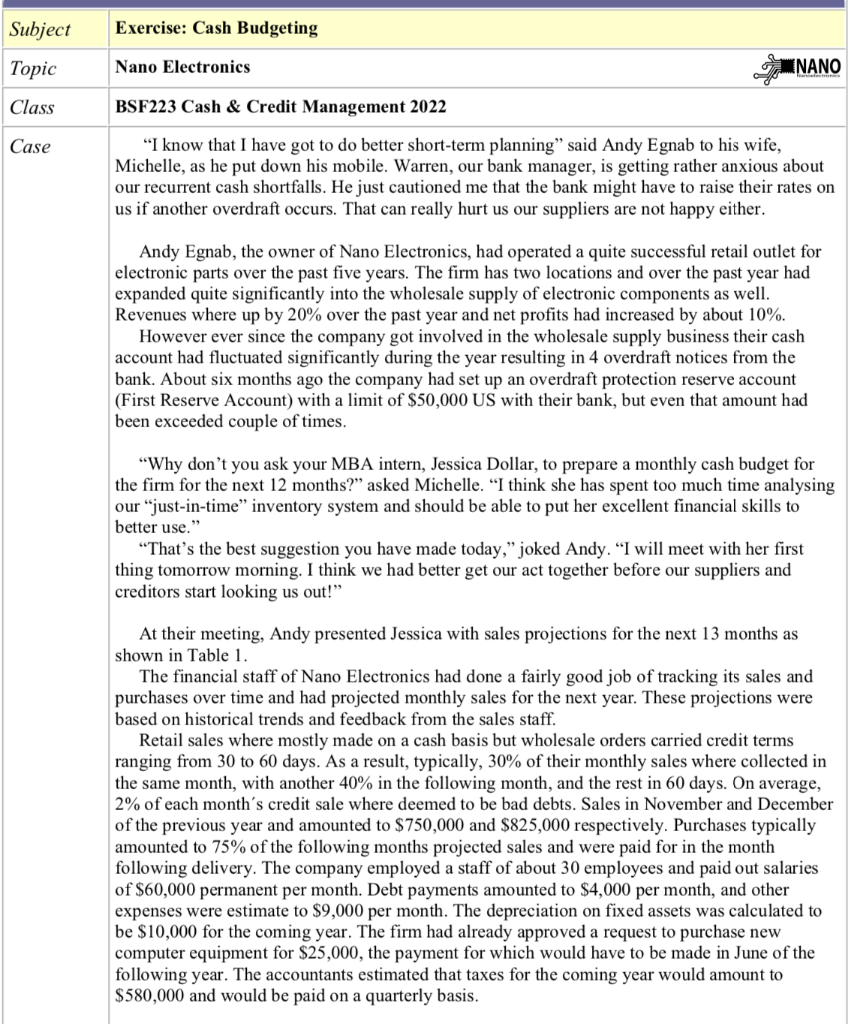
-
Prepare the collections worksheet. Which month has the greatest amount of cash inflows?
-
4) Prepare the disbursements worksheet. Which months seem to be hit by the highest amount of cash outflows? Why? Can this trend be changed?
-
5) How should the depreciation expense be treated in the cash budget?
-
6) Which months seem to be particularly vulnerable to cash deficits? Which months have the greatest surpluses?
-
7) If the cash balance outstanding is -$52,000, help Jessica develop a cash budget for Nano Electronics for the next 12 months. How can Andy use the cash budget to minimize the cash shortages and plan for the future?
-
8) Given that the monthly sales figures have been fluctuating so much what should Jessica do while preparing the cash budget? Can she take the sales figures provided by the financial department at face value? If so why? What other options does she have?
-
9) How can a minimum cash balance be built in? How much of a minimum cash balance seems warranted? What can the company do with the excess cash that is generated in some months?
-
10) Rework the budget by using your minimum cash balance.
Subject Topic Class Case Exercise: Cash Budgeting Nano Electronics BSF223 Cash & Credit Management 2022 "I know that I have got to do better short-term planning" said Andy Egnab to his wife, Michelle, as he put down his mobile. Warren, our bank manager, is getting rather anxious about our recurrent cash shortfalls. He just cautioned me that the bank might have to raise their rates on us if another overdraft occurs. That can really hurt us our suppliers are not happy either. Andy Egnab, the owner of Nano Electronics, had operated a quite successful retail outlet for electronic parts over the past five years. The firm has two locations and over the past year had expanded quite significantly into the wholesale supply of electronic components as well. Revenues where up by 20% over the past year and net profits had increased by about 10%. However ever since the company got involved in the wholesale supply business their cash account had fluctuated significantly during the year resulting in 4 overdraft notices from the bank. About six months ago the company had set up an overdraft protection reserve account (First Reserve Account) with a limit of $50,000 US with their bank, but even that amount had been exceeded couple of times. "Why don't you ask your MBA intern, Jessica Dollar, to prepare a monthly cash budget for the firm for the next 12 months?" asked Michelle. "I think she has spent too much time analysing our "just-in-time" inventory system and should be able to put her excellent financial skills to better use." "That's the best suggestion you have made today," joked Andy. "I will meet with her first thing tomorrow morning. I think we had better get our act together before our suppliers and creditors start looking us out!" At their meeting, Andy presented Jessica with sales projections for the next 13 months as shown in Table 1. The financial staff of Nano Electronics had done a fairly good job of tracking its sales and purchases over time and had projected monthly sales for the next year. These projections were based on historical trends and feedback from the sales staff. Retail sales where mostly made on a cash basis but wholesale orders carried credit terms ranging from 30 to 60 days. As a result, typically, 30% of their monthly sales where collected in the same month, with another 40% in the following month, and the rest in 60 days. On average, 2% of each month's credit sale where deemed to be bad debts. Sales in November and December of the previous year and amounted to $750,000 and $825,000 respectively. Purchases typically amounted to 75% of the following months projected sales and were paid for in the month following delivery. The company employed a staff of about 30 employees and paid out salaries of $60,000 permanent per month. Debt payments amounted to $4,000 per month, and other expenses were estimate to $9,000 per month. The depreciation on fixed assets was calculated to be $10,000 for the coming year. The firm had already approved a request to purchase new computer equipment for $25,000, the payment for which would have to be made in June of the following year. The accountants estimated that taxes for the coming year would amount to $580,000 and would be paid on a quarterly basis







